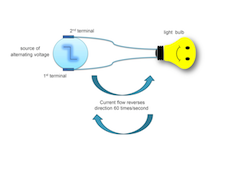You may have noticed that your home runs on either 120V or 240V instead of the 12, 24, or 48 volts a battery supplies. Off-grid homes, small holiday cottages, boats and recreational vehicles used to use 12V direct current systems but such low voltages (and DC) are only useful in very small installations. There are relatively few low-voltage appliances and wiring a low-voltage direct current system is often difficult and unviable for a typical home in full-time occupation.
Modern off-grid houses are equipped with 120V or 240V alternating current (AC). A DC circuit operates with its current flowing from the battery’s negative terminal through the desired load and back to the battery’s positive terminal. The current flows constantly in one direction, which is why it’s called direct route or direct current. An AC circuit allows the current to flow from one terminal to another via the load in between. But the current reverses flow direction many times per second; that is, it flows from the second to the first terminal via the load and vice-versa.
 Alternating Current in the Home
Alternating Current in the Home
Grid electricity is generated via mechanical turbines that turn electrical generators. When the electric system was still in its infancy, much debate surrounded whether the generator output should be AC or DC. Although it started off with both types, safety reasons (and other considerations) compelled the adoption of AC transmission over time. It has been that way ever since. Today, all of North America’s modern homes and electrical appliances use the standardized 120V/240V AC supply. Off-grid homes should convert any low-voltage battery bank to match the standard. The device that makes this possible is the inverter.